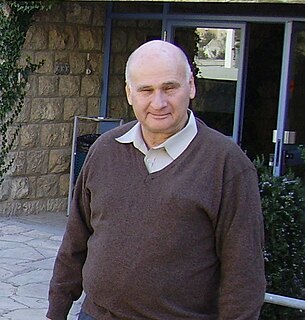In mathematics, the continuum hypothesis is a hypothesis about the possible sizes of infinite sets. It states:
There is no set whose cardinality is strictly between that of the integers and the real numbers.
In mathematics, especially in order theory, the cofinality cf(A) of a partially ordered set A is the least of the cardinalities of the cofinal subsets of A.
In the mathematical discipline of set theory, forcing is a technique for proving consistency and independence results. It was first used by Paul Cohen in 1963, to prove the independence of the axiom of choice and the continuum hypothesis from Zermelo–Fraenkel set theory.
In set theory, a Woodin cardinal is a cardinal number λ such that for all functions

In mathematics, particularly in set theory, the aleph numbers are a sequence of numbers used to represent the cardinality of infinite sets that can be well-ordered. They were introduced by the mathematician Georg Cantor and are named after the symbol he used to denote them, the Hebrew letter aleph.
In mathematical logic, the Löwenheim–Skolem theorem is a theorem on the existence and cardinality of models, named after Leopold Löwenheim and Thoralf Skolem.
In mathematics, limit cardinals are certain cardinal numbers. A cardinal number λ is a weak limit cardinal if λ is neither a successor cardinal nor zero. This means that one cannot "reach" λ from another cardinal by repeated successor operations. These cardinals are sometimes called simply "limit cardinals" when the context is clear.
In set theory, a regular cardinal is a cardinal number that is equal to its own cofinality. More explicitly, this means that is a regular cardinal if and only if every unbounded subset has cardinality . Infinite well-ordered cardinals that are not regular are called singular cardinals. Finite cardinal numbers are typically not called regular or singular.
In mathematics, the beth numbers are a certain sequence of infinite cardinal numbers, conventionally written , where is the second Hebrew letter (beth). The beth numbers are related to the aleph numbers, but there may be numbers indexed by that are not indexed by .
PCF theory is the name of a mathematical theory, introduced by Saharon Shelah (1978), that deals with the cofinality of the ultraproducts of ordered sets. It gives strong upper bounds on the cardinalities of power sets of singular cardinals, and has many more applications as well. The abbreviation "PCF" stands for "possible cofinalities".
In mathematics, specifically set theory and model theory, a stationary set is a set that is not too small in the sense that it intersects all club sets, and is analogous to a set of non-zero measure in measure theory. There are at least three closely related notions of stationary set, depending on whether one is looking at subsets of an ordinal, or subsets of something of given cardinality, or a powerset.
In model theory, a branch of mathematical logic, the spectrum of a theory is given by the number of isomorphism classes of models in various cardinalities. More precisely, for any complete theory T in a language we write I(T, α) for the number of models of T of cardinality α. The spectrum problem is to describe the possible behaviors of I(T, α) as a function of α. It has been almost completely solved for the case of a countable theory T.
Rami Grossberg is a full professor of mathematics at Carnegie Mellon University and works in model theory.
In the mathematical field of set theory, the proper forcing axiom (PFA) is a significant strengthening of Martin's axiom, where forcings with the countable chain condition (ccc) are replaced by proper forcings.
Frederick William Galvin is a mathematician, currently a professor at the University of Kansas. His research interests include set theory and combinatorics.
In mathematics, infinitary combinatorics, or combinatorial set theory, is an extension of ideas in combinatorics to infinite sets. Some of the things studied include continuous graphs and trees, extensions of Ramsey's theorem, and Martin's axiom. Recent developments concern combinatorics of the continuum and combinatorics on successors of singular cardinals.

Menachem Magidor is an Israeli mathematician who specializes in mathematical logic, in particular set theory. He served as President of the Hebrew University of Jerusalem, was President of the Association for Symbolic Logic from 1996 to 1998, and is currently the President of the Division for Logic, Methodology and Philosophy of Science and Technology of the International Union for History and Philosophy of Science. In 2016 he was elected an honorary foreign member of the American Academy of Arts and Sciences. In 2018 he received the Solomon Bublick Award.
This is a glossary of set theory.
In model theory, a discipline within the field of mathematical logic, a tame abstract elementary class is an abstract elementary class (AEC) which satisfies a locality property for types called tameness. Even though it appears implicitly in earlier work of Shelah, tameness as a property of AEC was first isolated by Grossberg and VanDieren, who observed that tame AECs were much easier to handle than general AECs.





































































